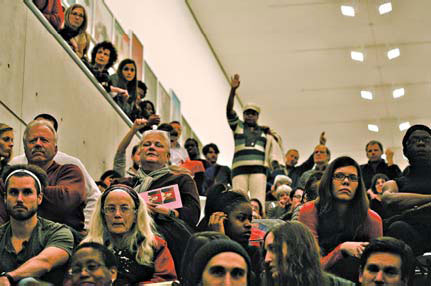An art world based on social practice
Updated: 2013-04-07 07:43
By Randy Kennedy(The New York Times)
|
|||||||
|
A town-hall meeting on racial and economic issues at the Pulitzer Foundation for the Arts in St. Louis drew 350 people. Regina martinez for The pulitzer foundation for the arts |

As the commercial art world in America rides a boom, another kind of art world is beginning to assert itself. Known primarily as social practice, its practitioners freely blur the lines among object making, performance, political activism, community organizing, environmentalism and investigative journalism, creating a deeply participatory art that often flourishes outside the gallery and museum system.
In Detroit a contemporary-art museum is completing a monument to an artist that will not feature his work but will provide food, haircuts, education programs and other social services to the public in the Michigan city. In New York an art organization that commissions public installations has been dispatching a journalist to politically precarious places around the world where she enlists artists and activists - often one and the same - to write for a Web site that can read more like a policy journal than an art portal. And in St. Louis, Missouri, an art institution is turning itself into a hub of social activism, recently organizing a town-hall meeting where 350 people crowded in to talk about de facto segregation, one of the city's most intractable problems.
If none of these projects sound much like art - or the art you are used to seeing in museums - that is precisely the point. Art institutions around the country are grappling with how to bring it within museum walls and make the case that it can be appreciated along with paintings and sculpture.
Leading museums have largely ignored it. But many smaller art institutions see it as a new frontier for a movement whose roots stretch back to the 1960s.
"You might want to put your head in the sand and say, 'I wish it was 40 years ago and it was different and art was more straightforward,' but it's not," said Nato Thompson, the chief curator of Creative Time, a New York nonprofit that is known for temporary public art installations.
Works can be as wildly varied as a community development project in Houston, Texas, that provides artists' studios and low-income housing, or a program in San Francisco founded by artists and financed by the city that helps turn yards, vacant lots and rooftops into gardens.
Art of this kind has thrived for decades, mostly in Europe and South America, but has recently caught fire with young Americans in what is partly a reaction to the art market's distorting power, fueled by a concentration of international wealth. But many artists say the motivation is much broader: to make a difference in the world that is more than aesthetic.
"The boundary lines about how art is being made are becoming much blurrier," said Laura Raicovich, who is Creative Time's director of global initiatives and runs a Web site called Creative Time Reports.
The site's recent pieces include a video by an Egyptian-Lebanese artist about Tahrir Square, the locus of the Egyptian uprising two years ago, and a film about family debt made by an art collective.
"We're not trying to do what journalism does," Ms. Raicovich said. "But we think artists can supplement and complement it through a different lens."
Tania Bruguera, a New York artist who is known for helping immigrants and has been supported by Creative Time, sometimes explains social-practice art with an anti-Modernist call to arms: "It's time to restore Marcel Duchamp's urinal to the bathroom."
The Pulitzer Foundation for the Arts, a private institution that opened in St. Louis in 2001, responded in December to racial and economic disparities in St. Louis by holding a town-hall meeting. "We wanted to start envisioning art more broadly," said Kristina Van Dyke, the foundation's director. "The question became: Could we effect social change through art, plain and simple?"
Some say institutions and artists should resist the urge for such change. Maureen Mullarkey, a New York painter, wrote on her blog "that art is increasingly not about art at all." Instead, she argued, it is "fast becoming a variant of community organizing by soi-disant promoters of their own notions of the common good."
The New York Times
(China Daily 04/07/2013 page9)
